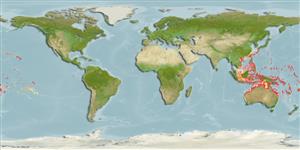Common names from other countries
>
Eupercaria/misc (Various families in series Eupercaria) >
Scaridae (Parrotfishes) > Scarinae
Etymology: Chlorurus: Greek, chloros = green + Greek oura = tail (Ref. 45335).
More on author: Bleeker.
Environment: milieu / climate zone / depth range / distribution range
Ecologia
marinhas associadas(os) a recifes; intervalo de profundidade 0 - 50 m (Ref. 90102), usually 1 - 15 m (Ref. 89972). Tropical; 31°N - 35°S, 105°E - 124°W
Pacific Ocean: Bali and the Philippines to the Line and Pitcairn islands, north to the Ryukyu Islands, south to Rottnest Island, Lord Howe Island and Rapa Island (Ref. 37816). The species complex comprise of Chlorurus gibbus in the Red Sea, Chlorurus strongylocephalus in the Indian Ocean and Chlorurus microrhinos in the west-central Pacific.
Tamanho / Peso / Idade
Maturity: Lm ? range ? - ? cm
Max length : 70.0 cm TL macho/indeterminado; (Ref. 2334); common length : 49.0 cm SL macho/indeterminado; (Ref. 37816); common length :40 cm SL (female); peso máx. publicado: 5.4 kg (Ref. 37816)
Descrição suscinta
Chaves de identificação | Morfologia | Morfometria
Espinhos dorsais (total) : 9; Raios dorsais (total) : 10; Espinhos anais: 3; Raios anais : 9. Juveniles below about 8 cm are black with several horizontal white streaks. Larger ones up to about 20 cm uniformly dark, greenish brown, slowly becoming blue with age. Blue streak and patch extending behind the corner of the mouth of large males often quite brilliant. Uniformly yellowish-tan individuals rare. Caudal fin lunate in large terminal males. Scale rows on cheek 3. Median predorsal scales 3-4 (Ref. 37816). Males develop large hump on head and appear blunt-headed (Ref. 48636).
Occurs in lagoon and seaward reefs. Juveniles generally solitary; large adults often school together. Feeds on benthic algae (Ref. 89972). Minimum depth reported taken from Ref. 128797.
Ciclo de vida ou comportamento de acasalamento
Maturities | Reprodução | Spawnings | Egg(s) | Fecundities | Larvas
Oviparous, distinct pairing during breeding (Ref. 205).
Parenti, P. and J.E. Randall, 2000. An annotated checklist of the species of the labroid fish families Labridae and Scaridae. Ichthyol. Bull. J.L.B. Smith Inst. Ichthyol. (68):1-97. (Ref. 35918)
Status na Lista Vermelha da UICN (Ref. 130435)
CITES (Ref. 128078)
Not Evaluated
Ameaça para os humanos
Reports of ciguatera poisoning (Ref. 4690)
Uso pelos humanos
Pescarias: espécies comerciais
Ferramentas
Relatórios especiais
Baixar XML
Fontes da internet
Estimates based on models
Preferred temperature (Ref.
115969): 24.8 - 29.3, mean 28.4 (based on 1923 cells).
Índice de diversidade filogenética (Ref.
82804): PD
50 = 0.5000 [Uniqueness, from 0.5 = low to 2.0 = high].
Bayesian length-weight: a=0.01445 (0.01199 - 0.01742), b=3.03 (2.98 - 3.08), in cm Total Length, based on LWR estimates for this species (Ref.
93245).
Resiliência (Ref.
120179): Baixo, tempo mínimo de duplicação da população 4,5 - 14 anos (tmax=14; k=0.22).
Fishing Vulnerability (Ref.
59153): Moderate to high vulnerability (48 of 100).
